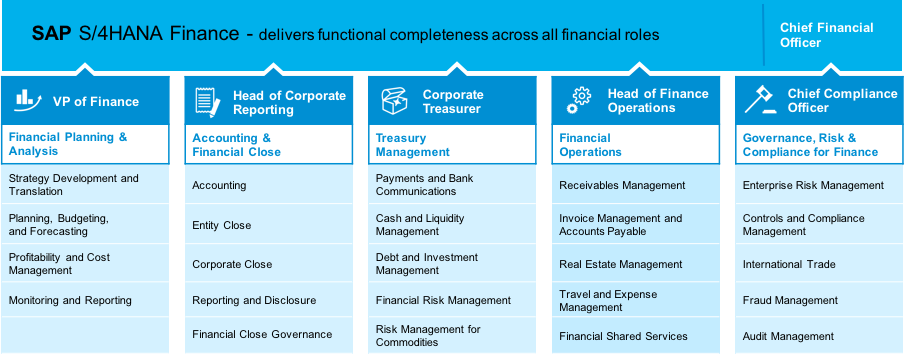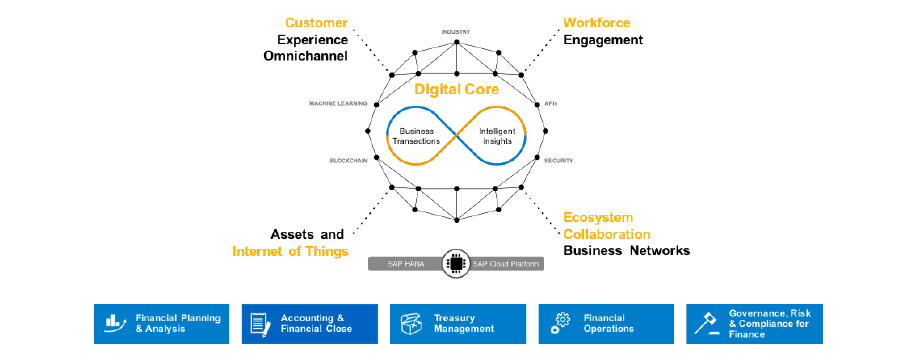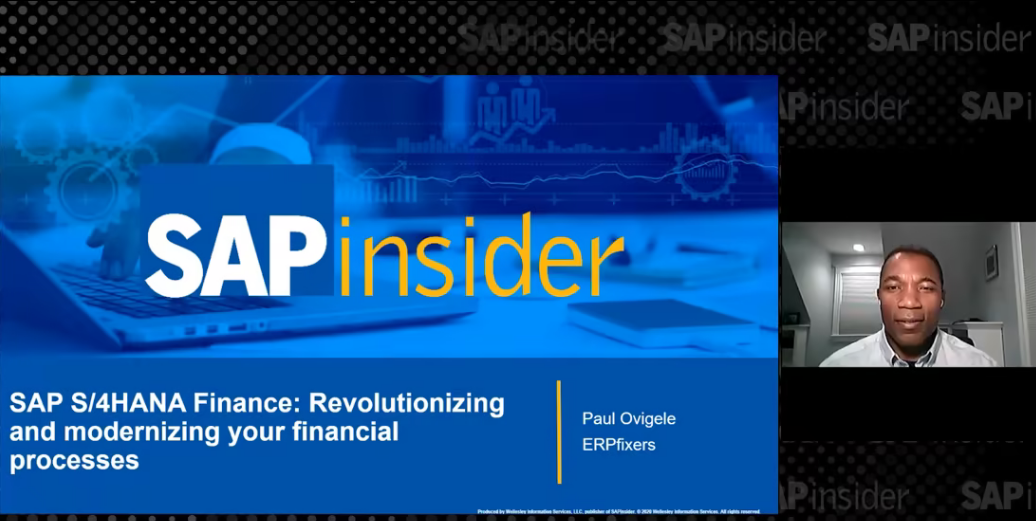SAP S/4HANA Finance: What’s in a Name?
Finance is currently at the forefront of technology innovations within SAP. By being the first line of business to re-architect the core finance and controlling capabilities to leverage the capabilities of SAP S/4HANA, finance professionals can increase their organizations’ efficiency through automation, thereby freeing up their bandwidth to leverage dynamic planning and modeling to provide insight into the financial impact of strategic business decisions.
The solution that enables finance to strategically guide organizations’ continued evolution is SAP S/4HANA Finance, which is part of the next-generation business suite, SAP S/4HANA (which stands for SAP Business Suite for SAP HANA). SAP S/4HANA is the heart of the digital core, which includes finance as well as other core lines of business, such as the extended supply chain. Refer to the sidebar “SAP S/4HANA Finance and the Digital Core” to see how finance fits into that bigger picture.
SAP S/4HANA Finance is a renaming of SAP Simple Finance. Even prior to the adoption of the name SAP Simple Finance, there were other names in play, sometimes with different definitions as to what was included in the scope. Some names, such as the Financials add-on for SAP HANA, referred only to the innovations within finance. Other names, such as SAP S/4HANA Finance (and previously SAP Simple Finance) refer to the entire portfolio. For a detailed look at the naming history, and the scope referenced by each name, see the sidebar “Evolution of the Naming of SAP S/4HANA Finance.”
Because of these frequent changes in naming, we come to the question that is top of mind for many customers: what, exactly, is meant by SAP S/4HANA Finance?
The Functional Scope of SAP S/4HANA Finance
SAP S/4HANA Finance refers to the entire portfolio of all SAP solutions for finance. These capabilities go across SAP ERP Financials, SAP enterprise performance management solutions (SAP EPM solutions), and SAP governance, risk, and compliance solutions (SAP GRC solutions). From a process perspective, that refers to the five end-to-end processes of the value map shown in Figure 1, including financial planning and analysis; accounting and financial close; treasury management; financial operations; and governance, risk and compliance for finance.

Deployment Modes
SAP S/4HANA Finance is available with all deployment modes:
- On premise. The full scope of the business suite, including lines of business and industry solutions, continues to be enhanced, and continues to be available on premise, meaning each customer installs and maintains the software, and can also extend the software. New innovations will be released on an annual basis.
- Private cloud. The private cloud offering also includes the full scope of the business suite, the difference being that the software is maintained by SAP. New innovations will also be released annually. There are two options for the private cloud. The SAP HANA Enterprise Cloud allows for full extensibility and customizations. The SAP S/4 HANA Cloud, private option, relies on standard modules and does not allow modifications, but does allow for extensibility via the SAP Cloud Platform, where SAP continues to provide standard applications and innovations, such as SAP RealSpend and SAP Cash Application. New innovations will be released on an annual basis; for the SAP HANA Cloud, private option, those innovations will be upgraded by SAP as soon as they are available.
- Public cloud. SAP S/4HANA Cloud for finance is a new solution that refers specifically to capabilities available in the public cloud, and it is maintained by SAP. The core financial capabilities are available, which are often used for subsidiaries, acquired companies, and small and medium-sized enterprise (SME) companies, but can also be leveraged by large enterprises. Configuration is possible, but no changes to the core code can be made. Extensibility is provided by the SAP Cloud Platform. New innovations will be released on a quarterly basis.
Customers can also run hybrid scenarios, meaning that companies that are running SAP S/4HANA Finance on premise or in the private cloud can put only selected capabilities into the cloud. Examples include having subsidiaries run on the SAP S/4HANA Cloud for finance, or running supplier collaboration and invoice management with SAP Ariba with an integration back into SAP S/4HANA Finance.
(Note: One particular scenario of interest is SAP S/4HANA for central finance foundation, which is an example of a hybrid deployment mode. In this scenario, there may be multiple back ends, either SAP or non-SAP. However, a company may still want to leverage SAP S/4HANA Finance without having to upgrade each back-end system to SAP S/4HANA. In this case, a separate instance of SAP S/4HANA Finance is put into place, and the back-end systems are mapped to this central finance instance. Local reporting and integration into logistics activities continue to take place in the originating systems. Corporate-level activities then take place within SAP Central Finance as the system of record — for example, management reporting across all systems and business units, consolidation, intercompany reconciliation, and top-level planning.)
Innovations within SAP S/4HANA Finance
Let’s take a closer look at the first innovations that were re-architected to leverage the in-memory technology of SAP HANA. Again, these are part of the overall portfolio of SAP S/4HANA Finance; we use the following component names of each of these capabilities:
- SAP Accounting powered by SAP HANA. With the in-memory technology of SAP HANA, there is no more need for totals and summary tables or index tables, which reduces the system footprint required to run Finance. In addition, the separate tables across finance and controlling are all combined into one table, the universal journal (table ACDOCA). This includes the general ledger (customers can migrate to the universal journal either from the classic general ledger or from the SAP General Ledger); subledger information, including accounts payable, accounts receivable, and fixed assets; managerial accounting data such as cost centers, internal orders, projects, and so on; the material ledger; and account-based profitability analysis (the CO-PA module configured to include G/L accounts). Only cost-based profitability analysis (the CO-PA module configured to use value fields) continues to use its own database, since there is no 1:1 mapping from general ledger accounts to value fields. Also, operational information is now included in the universal journal, such as customer, vendor, asset, and product codes, enabling better cross-functional reporting. Business users can configure the fields that they need, without requiring IT intervention.
- SAP Smart Business cockpits. The transactions available in the universal journal can be accessed directly in real time, enabling a real-time calculation of summary information, such as account balances for financial statements and profit and cost center balances; the calculation of key performance indicators (KPIs) such as operating margins; trends such as outstanding receivables over time; and predictive capabilities such as cash and liquidity planning. These capabilities are delivered using dashboards, leveraging SAP Fiori. In addition to providing executive-level detail, individual business users can configure the parameters of these KPIs—for example, adjusting the tolerance of receivables outstanding. These dashboards also facilitate drill down into the granular details if the KPIs indicate an issue.
- Integrated business planning. The vision behind this scenario is that planning should not take place in silos, and should include operational planning. From a supply chain perspective, the solution is referred to as SAP Integrated Business Planning.
From a financial perspective, in the past there were different plans for cost centers, internal orders, projects, profit centers, and so on; however, these plans were not tied together. In addition, there are operational plans that also have a financial impact, such as sales planning and pricing affecting revenue plans, and production and HR plans affecting cost plans. Finally, subsidiary and business unit planning need to roll up to corporate plans.
SAP Integrated Business Planning for finance seeks to bring all these plans together, to enable what-if simulations to determine the best course of action. From a product perspective, customers have two options. Newly available with SAP S/4HANA is an embedded SAP Business Planning and Consolidation (SAP BPC) as part of the SAP S/4HANA infrastructure, so no replication to another server is necessary; this is referred to as SAP Business Planning and Consolidation for SAP S/4HANA. SAP BPC can still be implemented on a separate server, for example, by using SAP Business Planning and Consolidation for SAP S/4HANA, version for SAP NetWeaver.
When the first innovations were announced for SAP S/4HANA Finance, it only encompassed the core financial accounting and controlling functions, selected financial operations capabilities, and planning. In addition, fraud management and audit management capabilities in the SAP GRC portfolio were written directly for SAP HANA, and are not available without SAP HANA. These capabilities also included integration with cloud solutions to support hybrid scenarios.
Throughout this past year, additional areas within the finance portfolio of SAP S/4HANA Finance have been re-architected, such as the consolidations processes within SAP BPC as part of the corporate close. All new innovations, such as those using the SAP Cloud Platform, are built natively to leverage the innovations available with SAP HANA.











